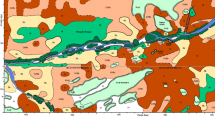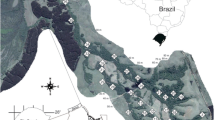Abstract
The riparian forests along braided rivers are dynamic, frequently rejuvenated by floods and channel changes, and thus dominated by pioneer to middle stages of succession; they are sites of high biodiversity in some regions. The Lower Eygues River (drainage area 1150 km2 in southeastern France) is such a braided river system with large alluvial forests dominated by Salix alba, Populus alba, and P. nigra. It was identified as a site of ecological interest by the EU under the Natura 2000 program. Such forests elsewhere in Europe have been identified as reference ecosystems. We documented the historical evolution of this alluvial forest from detailed (1:2500 scale) early 19th C parcel maps, early 20th C topographic maps, aerial photography from 1947 to 1996, and field surveys of topography and riparian vegetation in 1997–1998. Our results show that in 1830, the channel was wide, aggraded, and agricultural pressure extended literally to the channel edge. With decline in the rural population and reduced agricultural and grazing pressure in the catchment, erosion rates declined. Reduced sediment supply led to channel narrowing and incision. This channel narrowing, coupled with reduced agricultural pressure along the banks, has allowed riparian forest to colonize former active channel areas, especially within late 19th-century 20th century flood dykes. In recent decades, aggregate mining, and clearing for recreation and agriculture have fragmented the forest. Thus, the alluvial forest of the Lower Eygues is largely an artifact of changing human land-use over the past century, a context that should frame efforts for preservation and restoration.













Similar content being viewed by others
References
Amoros C, Petts GE (eds) (1993) Hydrosystèmes fluviaux. Coll. d’écologie-24
Blanchet G, Deblaere JC (1993) L’épisode pluvio-orageux catastrophique de septembre 1992 dans le sud-est de la France: Analyse pluviométrique et météorologique. Revue de Géographie de Lyon 68:129–152
Burgherr P, Robinson CT, Ward JV (2002) Seasonal variation in zoobenthos across habitat gradients in an alpine glacial floodplain (Val Roseg, Swiss Alps). J Am Benthol Soc 21:561–575
Greco SE, Plant RE (2003) Temporal mapping of riparian landscape change on the Sacramento River, Miles 196–218, California, USA. Landscape Research 28(4):405–426
Hughes FMR (ed) (2003) The flooded forest: Guidance for policy makers and river managers in Europe on the restoration of floodplain forests. Department of Geography, University of Cambridge, UK
Johnson WC (1992) Dams and riparian forests: Cast study from the upper Missouri River. Rivers 3:229–242
Karrenberg PJ, Edwards PJ, Kollmann J (2002) The life history of Salicaceae living in the active zone of floodplains. Freshwater Biol 47:733–748
Kondolf GM, Larson M (1995) Historical channel analysis and its application to riparian and aquatic habitat restoration. Aquat Conserv 5:109–126
Landon N, Piégay H (1999) Propositions pour une gestion physique équilibrée du lit de l’Eygues et de son bassin versant. Final report to the Syndicat Mixte d’Aménagement Rural de la Drôme et Syndicats drômois et vauclusiens de l’Eygues, CNRS UMR 5600, Lyon
Liébault F, Piégay H (2002) Causes of 20th century channel narrowing in mountain and piedmont rivers and streams of Southeastern France. Earth Surf Proc Land 27:425–444
Liébault F, Clément P, Piégay H, Rogers CF, Kondolf GM, Landon N (2002) Contemporary channel changes in the Eygues River basin, southern French Prealps: The relationship of sub-basin variability to watershed characteristics. Geomorphology 45:53–66
Malanson GP (1993) Riparian landscapes: Cambridge studies in ecology. Cambridge University Press, Cambridge
Marston RA, Girel J, Pautou G, Piégay H, Bravard JP, Arneson C (1995) Channel metamorphosis, floodplain disturbance, and vegetation development: Ain River, France. Geomorphology 13:121–131
Michelot JL (1995) Gestion patrimoniale des milieux naturels fluviaux (guide technique), Réserves Naturelles de France
Naiman RJ, Décamps H, Pollock M (1993) The role of riparian corridors in maintaining regional biodiversity. Ecol Appl 3:209–212
NRC (National Research Council) (2002) Riparian areas, functions and strategies for management. National Academy Press, Washington D.C. U.S.
Piégay H, Landon N (1997) Promoting an ecological management of riparian forests on the Drôme River, France. Aquat Conserv 7:287–304
Piégay H, Pautou G, Bravard JP (2003) Les ripisylves du Rhône et de ses affluents: Une histoire contemporaine. In: Piégay H, Pautou G, Ruffinoni C (eds) Les forêts riveraines: Écologie, fonctions, gestion. Institut pour le Développement Forestier, Paris
Schiemer F, Zalewski M (1992) The importance of riparian ecotones for diversity and productivity of riverine fish communities. Neth J Zool 42:323–335
SOGREAH (1987) Schéma d’aménagement hydraulique de la rivière Aygues. Unpublished Report and maps, SMARD, Agence de l’eau RMC, Région Rhône-Alpes
Tabacchi E, Planty-Tabacchi A-M (1996) Landscape structure and diversity in riparian plant communities: A longitudinal comparative study. Regulated Rivers: Research and Management 12:367–390
Tockner K, Stanford JA (2002) Riverine flood plains: Present state and future trends. Environ Conserv 29:308–330
Tockner K, Ward JV, Arscott BA, Edwards PJ, Kollmann J, Gurnell AM, Petts GE, Maiolini B (2003) The Tagliamento River: A model ecosystem of European importance. Aquat Sci 65:239–253
Ward JV, Tockner K, Edwards PJ, Kollmann J, Bretschko G, Gurnell AM, Petts GE, Rossaro B (1999) A reference system for the Alps: The ‘Fiume Tagliamento’. Regulated Rivers: Research & Management 15:63–75
Acknowledgements
Data collection and initial analysis for this study was supported by a Fulbright Senior Scholar grant from the Franco-American Commission for Cultural Exchange, and by a contract to support work by the Centre National de la Recherche Scientifique UMR 5600, Lyon from the Syndicat Mixte d’Aménagement Rural de la Drôme and the Syndicats drômois et vauclusiens de l’Eygues. Synthesis and manuscript preparation were supported by a grant under the Alumni Initiatives Award program of Council for International Exchange of Scholars. The staff of the Departmental Archives of the Drôme in Valence was especially helpful in making available departmental records and providing permission to use the cadastral maps. Michelle Bunge, Gretchen Coffman, Margaret Lang, and Steve Railsback helped with the field work. The comments of anonymous reviewers and Associate Editor Tim Kratz substantially improved the paper.
Author information
Authors and Affiliations
Corresponding author
Rights and permissions
About this article
Cite this article
Kondolf, G.M., Piégay, H. & Landon, N. Changes in the riparian zone of the lower Eygues River, France, since 1830. Landscape Ecol 22, 367–384 (2007). https://doi.org/10.1007/s10980-006-9033-y
Received:
Accepted:
Published:
Issue Date:
DOI: https://doi.org/10.1007/s10980-006-9033-y




